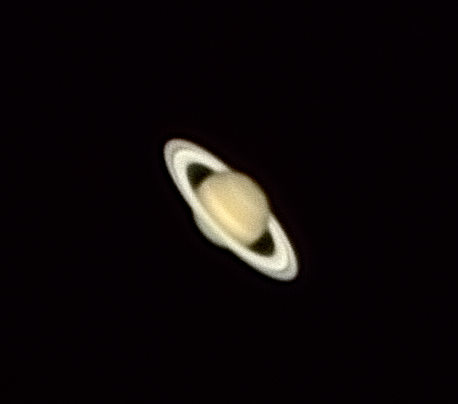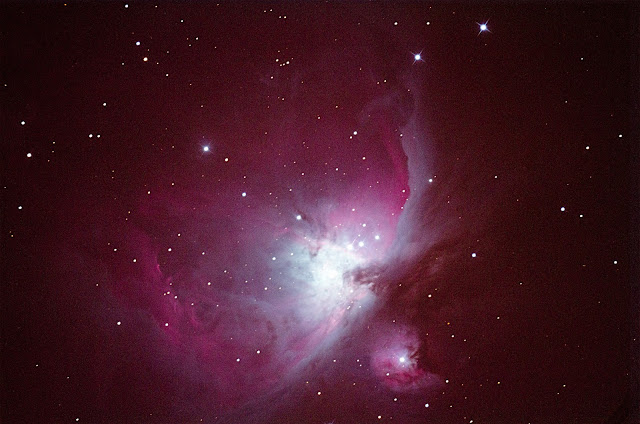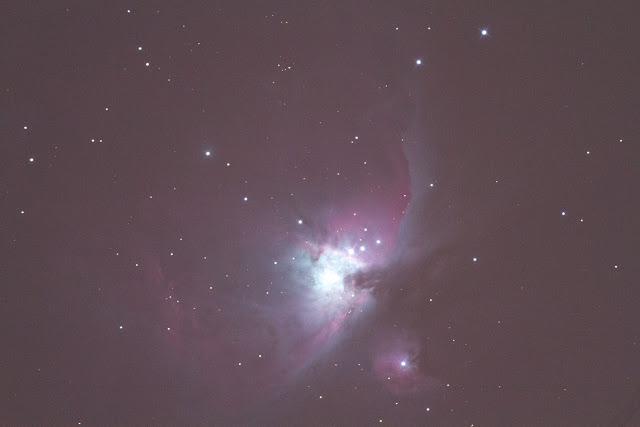Planets - A Quick Summary
I'll start with a summary relating to observing and imaging planets. Specifically Jupiter and Saturn, which I find the most interesting.
- Planets are very small in the sky.
- Saturn and Jupiter provide the best views as they are large, unique, although far away.
- Mars looks like a red/orange ball.
- Venus can be seen to have phases, just as with the moon. It is otherwise featureless.
- The other planets won't show any details except for colour.
What do I need to view planets?
Using Saturn and Jupiter as an example:
- Magnification is important to provide a larger view.
- Any telescope where the focal length, eyepiece, and other lenses such as barlows provide suitable magnification. Around 120x magnification is the minimum you'd want. The photo of Saturn above was produced at about 291x magnification, although through an eyepiece it will look several times smaller (the camera can produce a large image due to the sensor resolution).
- I have a 400mm refractor and with an 11mm eyepiece and 3x barlow (about 120x magnification):
- Will show Saturn, with bulges of the rings just visible (this is small).
- Jupiter will be visible as a small ball, possibly with a storm band visible. Four or five moons are typically visible as bright dots.
- You definitely know you're looking at these two planets rather than stars.
- I have a 1500mm Newtonian telescope and with a 4x Televue Powermate and 11mm eyepiece - this is pushing the limit of this telescope in urban skies (about 545x magnification):
- The dark divisions of the rings of Saturn are visible.
- Multiple bands of Jupiter are visible.
- Nicely sized view.
- Produces a dimmer view than at a lower magnification, however.
- When using high magnification, a steady mount that is easy to aim and keep on the target is important. It's very easy to lose the target when you don't have fine control or the telescope wobbles.
- Aperture isn't so important because planets are bright. Larger aperture telescopes allow collection of more light, which is useful for viewing fainter objects. That said, a greater aperture will produce a brighter view at higher magnifications. This will likely be negated by the magnified atmospheric turbulence, however.
What do I need to photograph planets?
Single exposures (images) of planets will generally appear blurry. The reason for this is that the atmosphere is turbulent and the planets are small in the sky. Even when looking through an eyepiece, Jupiter and Saturn will sometimes often be blurry and then occasionally appear quite sharp. Therefore a single photo will generally catch the planet during a blurry moment. Also, when visually observing, your brain is especially good at putting together a clearer view than is there at any single point in time, so it always appears much shaper when looking through an eyepiece.
The best approach to imaging planets is to record a video. Digital cameras will typically record 30 frames per second, and with enough footage (a few thousand frames, for example), there should be enough sharp frames that can be identified and stacked together using software such as Registax. There are plenty of tutorials online for using image stacking to produce better planetary imaging results. In my view, Registax isn't very intuitive to use, but once you know how to use it and work with the limitations, you can produce good results - for free! There are also commercial product offerings out there for planetary image stacking. Keep in mind that some stacking software is designed for deep sky objects only, rather than planets.
People also use high frame rate web cams to increase the number of frames that they can capture.
With a little more practice (the image on the right was produced from the first night of trying out my new imaging scope and mount), I'll hopefully be able to produce better results. Actually, I was shooting through thin cloud at the time, but it still appears sharper than my very early attempt on the left.
So, all you need is:
- A telescope with suitable magnification (136x and above is good - for greater size and details, more like 300x).
- A video-capable digital camera.
- A T-mount adapter for your telescope and matching T-ring for your camera (if it is a camera that accepts interchangeable lenses). Otherwise, a regular compact camera or web cam can be fixed to the telescope as you see fit.
- Some frame stacking software.
- A reasonably steady mount. Note that if you don't have a polar aligned equatorial mount, videos shouldn't be too long as rotation of the view will cause the planet to be smudged when stacked (if you don't 'unrotate' the frames to align them). In this case, try a minute or so initially to see what kind of result you get.
Here's a comparison of a single exposure of Saturn versus an image produced from stacking about 2000 frames and using wavelet filtering to enhance details.
 |
| Comparison of image capture techniques for Saturn (100% crop). |
Here's an older, but reasonably comprehensive article describing the stacking process:
Sky & Telescope magazine article link.
Rather than muck around with laptops and webcams, I just attach my Olympus PEN E-P3 micro four thirds camera to the telescope. You can do the same with any DSLR camera and a t-mount adapter.
I typically use Final Cut Pro (I use a Mac and use it for other video work) to export the frames from the video, then load those into Registax for alignment and stacking. Registax loads AVI video directly, but other formats will need converting or frame exporting as I do.
Planets - Lessons Learned
I was able to successfully capture images of planets using my 12 inch Dob Newtonian with a 4x Powermate. The main issue being that the scope is long (the tube is 1.4 m long) and heavy (20kg). It therefore wobbles with minimal encouragement. That said, the Alt-Az tracking on the Dob mount works well enough to keep a planet with view for long enough to walk away and fetch something or to record a video for lots of frames.
Another issue is that with the camera attached at prime focus (no powermates, barlows, lenses, or eyepieces between the cameras and scope), the Newtonian focus point is just out of reach for the moon. I tried slightly collapsing the tube to help. This worked, but throws the mirror collimation out, so more of a pain than it is worth. With the Powermate or a Barlow, this isn't a problem. Note that there are Newtonian tubes designed specifically to address this kind of problem.
Visual observation of Saturn and Jupiter, even with the 4x Powermate and a high power eyepiece produced big, sharp views when the atmosphere was cooperating.
Imaging is made easier with the RC8, however. The tube is under a third of the weight of the 12 inch Newtonian and under a third of the tube length, but with a slightly greater focal length. Makes for much steadier imaging on a given mount and the imaging train and focus point is designed for attaching cameras and other imaging related equipment.
When capturing video, your camera may not give you control over the exposure and may be just 1/30th of a second. This may not be the ideal exposure for your target (Mars appears really dull at high magnification for me when I record video like this). If you can't select a video format with a suitable frame rate, you may need to increase the ISO when recording video or else process the result frame or stacked image afterwards to make the planet brighter.
My 400mm refractor was good for viewing and imaging on an occasion when the moon was occulting Jupiter. It allowed for a wide view that included both objects when they were far apart, but approaching each other. Jupiter was of course small, but definitely a planet rather than a star. Also, this focal length was good for larger nebulae such as Eta Carina - my longer focal length scopes get a bit too close. Also, I couldn't view this at the time from my inner-city deck, so had to go mobile - hence use of the smaller scope. I didn't need a tracking mount for this because only short exposure were required.
 |
| The moon and Jupiter (on the right) with my 400mm refractor at prime focus. Slightly red due to some bush fires at the time. |
 |
| Same again, but this time over-exposed in order to capture some moons of Jupiter (click for larger view). |
More posts to follow soon...
- My gear - pros and cons.
- A good all-rounder setup.
- General observing.
- The moon.
- Nebulae.
- Urban astronomy.
- Astrophotography.
- Star parties.



